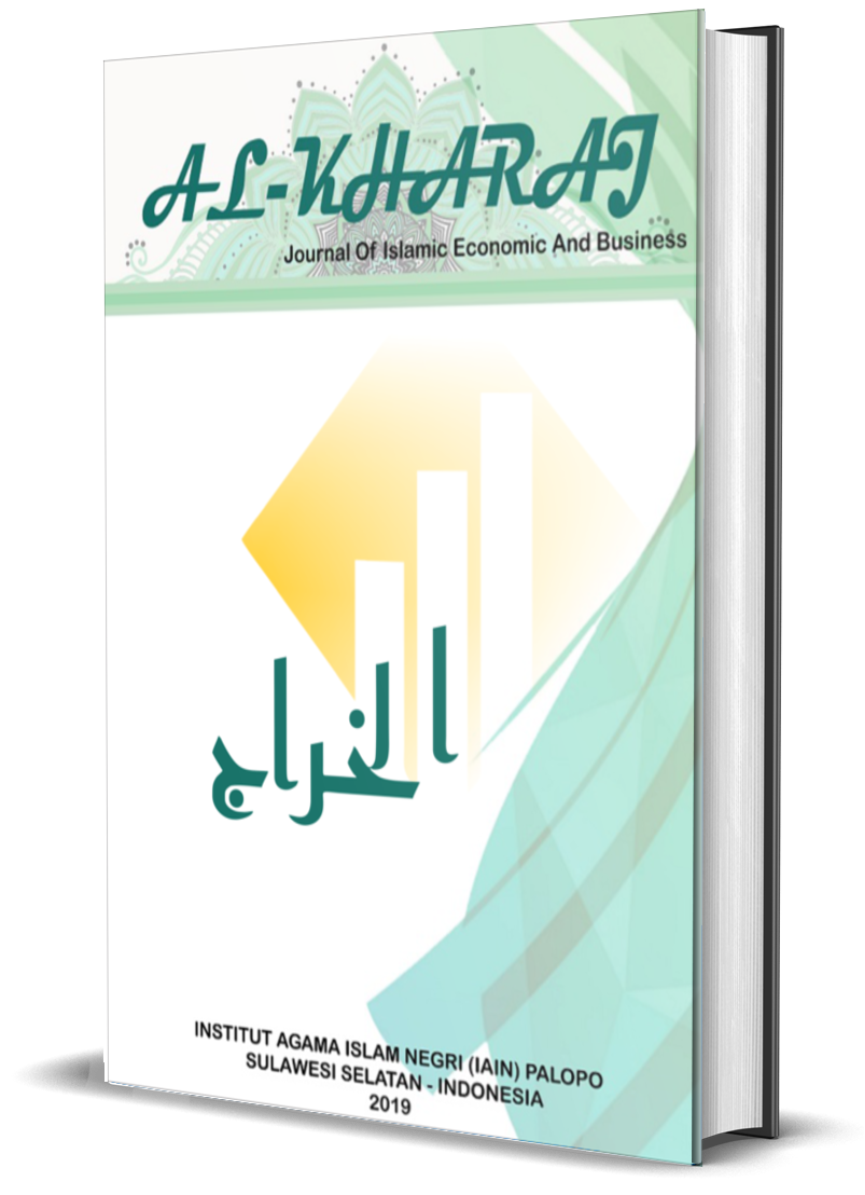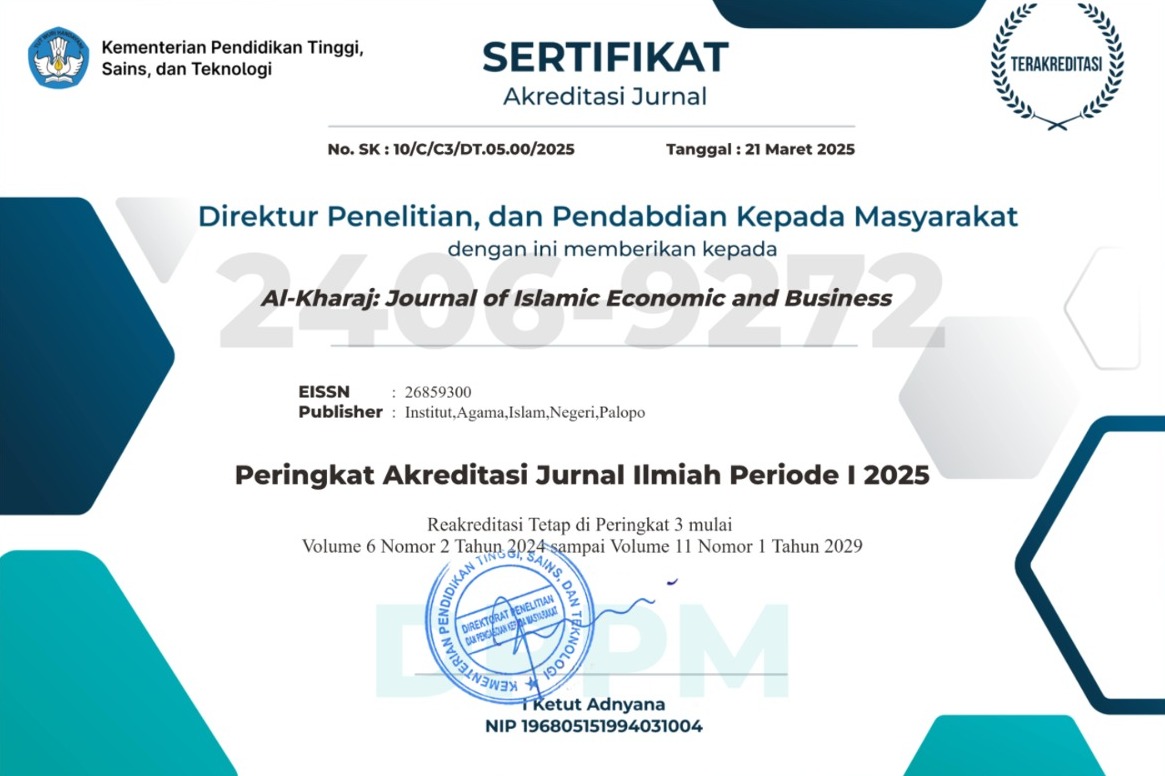The Influence Of Financial Literacy And Lifestyle On The Ability To Pay Spaylater Among Gen Z
DOI:
https://doi.org/10.24256/kharaj.v7i3.7664Keywords:
Financial Literacy, Lifestyle, Ability to Pay, SPaylaterAbstract
This study aimed to analyze the influence of financial literacy and lifestyle on SPaylater repayment capacity among Generation Z residing in Medan. The research method used was an associative quantitative survey approach, involving 100 participants selected using a purposive sampling technique. The research findings indicate that financial literacy has a significant positive impact on respondents' capacity to fulfill SPaylater payment obligations. Furthermore, lifestyle also makes a significant positive contribution to this payment capacity. These two variables, both individually and collectively, have been shown to significantly contribute to explaining variations in Generation Z's ability to fulfill digital payment obligations. These findings emphasize the importance of improving financial literacy and adopting a better and wiser lifestyle so that the younger generation can better manage their finances in the face of the development of digital financial services such as SPaylater.
References
Affandi, A., Siswanto, H., & Supriyanto, B. (2024). Analysis of Ability-to-Pay and Willingness-to-Pay for Public Transportation Services on the AL Route (Arjosari-Landungsari) in Malang City. Civil Engineering Media, 22(1), 18–23.
Ananda, F., Haris, S., & Erwansyah. (2023). Adolescent Consumer Behavior in Coffee Shops in Muntok City. Journal of Social Sciences, Management, and Accounting (JISMA), 2(1), 875–880. https://melatijournal.com/index.php/jisma/article/view/326
Andriyani, SS, Budidharmanto, LP, & Junianto, Y. (2022). Effects of Financial Literacy and Financial Management Teaching on Financial Behavior (Student Study of Hotel & Tourism Business Study Program). Primanomics: Journal of Economics & Business, 20(2), 139–148. https://doi.org/10.31253/pe.v20i2.1180
Ardhia Prameswari, Dinda Namira Hsb, Luthfiah Nur Bayani, N. (2021). Analysis of Factors Influencing Consumer Interest in Using E-Wallet Payment Systems (Case Study of UINSU Medan Students). Al-Sharf: Journal of Islamic Economics, 2(2), 126–139. https://doi.org/10.56114/al-sharf.v2i2.191
Farizqi, AI, Soleh, A., & Febliansa, MR (2022). Factors Influencing Shopee Pay Later User Interest in Bengkulu. SN-EMBA, 21–32.
Haiqal, MR, Bintari, WC, & Hidayah, N. (2024). The Influence of Financial Literacy and Lifestyle on Students' Interest in Using Paylater (A Study of Students at Muhammadiyah University of Sorong). Analysis, 14(2), 413–427. https://doi.org/10.37478/als.v14i2.4548
Harianto, A., Djohan, D., Razaq, MR, Akuntansi, P., Bisnis, I., Teknologi, I., Akuntansi, P., & Multismart, S. (2024). The Influence of Generation Z Lifestyle and Personality on the Use of Online Loans (Case Study of Generation Z in Medan City with Financial Applications (Fintech). Bikom, 06(02), 1–11.
Hidayah, FN, Nugroho, BS, Ardiati, AR, Tsaqyfa, MN, Hakim, MA, & Ridlwan, AA (2023). Examining the Rise of Online Loans Among College Students: Motives and Impact on Consumptive Behavior. Journal of Management Science, 11(4), 821–832.
Hildayanti, AN, Batara, AS, & Alwi, MK (2021). Determinants of Ability to Pay and Willingness to Pay Contributions of Independent BPJS Kesehatan Participants in Takabonerate District (Case Study in Selayar Islands Regency). Promotif: Journal of Public Health, 11(1), 30–37. https://doi.org/10.56338/pjkm.v11i1.1515
Lestari, D., Ilato, R., & Radia, A. (2023). The Influence of Life Skills and Lifestyle on Students' Consumptive Lifestyle Patterns. Oikos-Nomos: JOURNAL OF ECONOMIC AND BUSINESS STUDIES, 16(1), 1–15.
Lusardi, A., & Mitchell, O. S. (2023). The Importance of Financial Literacy: Opening a New Field. Journal of Economic Perspectives, 37(4), 137–154. https://doi.org/10.1257/jep.37.4.137
Murpratiwi, O., Nugroho Teguh Benianto, & Sujoko. (2022). Analysis of Ease of Making Payments, Ability to Pay, and Compliance with Payment of Contributions by Independent Participants of the National Health Insurance: A Study of Independent Participants of the BPJS Kesehatan Magelang Branch Office (2020). Journal of Economics, Business, and Management, 1(4), 230–257. https://doi.org/10.58192/ebismen.v1i4.161
Nasution, UI, K, K., & Rahmani, NAB (2023). The Influence of Financial Inclusion and Financial Literacy on Financial Performance (Case Study of Bank Sumut Syariah Panyabungan). EKOMBIS REVIEW: Scientific Journal of Economics and Business, 12(1), 1–10. https://doi.org/10.37676/ekombis.v12i1.4845
Oktaviani, M., Oktaria, M., Alexandro, R., Eriawaty, E., & Rahman, R. (2023). The Influence of Financial Literacy on Generation Z Consumer Behavior in College Students. Journal of Social Sciences, 9(2), 136–145. https://doi.org/10.23887/jiis.v9i2.68587
Rahmawati, G., & Mirati, E. (2022). The Influence of Financial Literacy and Lifestyle on the Consumptive Behavior of Shopee Paylater Users Among the Millennial Generation. Proceedings of SNAM PNJ, 3, 1–10.
Restike, KP, Presasti, D., Fitriani, DI, & Ciptani, MK (2024). The Influence of Financial Literacy, Impulsive Buying Behavior, and Lifestyle on Gen Z's Use of Shopee Paylater. Journal of Business Accounting, 22(1), 100–113. https://doi.org/10.24167/jab.v22i1.11609
Riduwan, R., Sang, M., Pakarti, A., Amrullah, A., & Dahlan, UA (2024). Sharia Financial Literacy: The Dangers of Online Loans to Religion and the Economy. Multidisciplinary Community Service Journal, 4, 1–4.
Safitri, LA, & Dewa, CB (2022). Analysis of the Influence of Financial Literacy Through Instagram Social Media on Generation Z's Financial Management. ASSET: Journal of Management and Business, 5(2). https://doi.org/10.24269/asset.v5i2.6030
Sanjaya, NA and VF (2021). The Influence of Lifestyle and Fashion Trends on Online Purchase Decisions for Fashion Products on Instagram. Saburai Journal of Management Science, 07(02), 125–131.
Saputra, VRJ, & Sudarwanto, T. (2023). The Influence of Lifestyle, Trust, and Convenience on Purchasing Decisions Using Shopee Paylater in Surabaya City. Journal of Commerce Education (JPTN), 11(2), 165–173.
Saragih, HS, Soemitra, A., & Nurbaiti, N. (2023). The Influence of Promotion, Perceived Benefits, and Lifestyle on the Decision to Use E-Wallets. Journal of Economic Education (JURKAMI), 8(3), 639–649. https://doi.org/10.31932/jpe.v8i3.2963
Silvialorensa, DD, Hartono, & Dwihandoko, TH (2024). The Influence of Financial Literacy and Lifestyle on SPaylater Usage among Generation Z in Magersari District, Mojokerto City. EBISMAN: EBisnis Manajemen, 2(3), 51–66.
Siregar, WSS, Nasution, AIL, & Nurwani. (2023). The Influence of Perceived Usefulness, Perceived Ease of Use, and Perceived Risk - Winda Suciani et al. JOURNAL OF SYNTAX TRANSFORMATION, 4(4), 44–56.
Sulhan, M., & Choiruddin, MN (2021). Analysis of the Impact of Financial Knowledge, Financial Attitudes and Personality on Financial Management Behaviors in Creative Industries. Proceedings of the International Conference on Engineering, Technology and Social Science (ICONETOS 2020), 529(Iconetos 2020), 549–557. https://doi.org/10.2991/assehr.k.210421.081
Syahputra, A., Kaswinata, K., Tanjung, H., Rahmani, NAB, & Dzuljastri, D. (2023). Globalization & Development of Sharia Financial Technology in Indonesia. Journal of Finance and Banking Sciences (JIKA), 13(1), 103–114. https://doi.org/10.34010/jika.v13i1.11288
Downloads
Published
How to Cite
Issue
Section
Citation Check
License
Copyright (c) 2025 Sagdiyah Fitri Andani Tambunan, Nur Ahmadi Bi Rahmani, Aqwa Naser Daulay

This work is licensed under a Creative Commons Attribution-ShareAlike 4.0 International License.
Authors retain copyright and grant the journal right of first publication with the work simultaneously licensed under a Creative Commons Attribution-ShareAlike 4.0 International License. In line with the license, authors are allowed to share and adapt the material. In addition, the material must be given appropriate credit, provided with a link to the license, and indicated if changes were made. If authors remix, transform or build upon the material, authors must distribute their contributions under the same license as the original.









